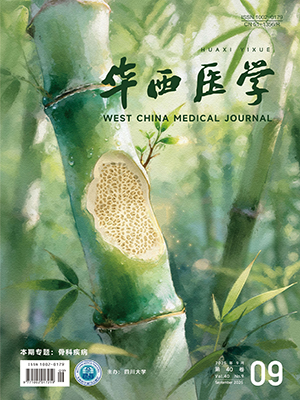| 1. |
Arnold WV, Shirtliff ME, Stoodley P. Bacterial biofilms and periprosthetic infections[J]. J Bone Joint Surg Am, 2013, 95(24): 2223-2229.
|
| 2. |
Shanmugasundaram S, Riccardi BF, Briggs TW, et al. Evaluation and management of periprosthetic joint infection: an international multicenter study[J]. HSS J, 2014, 10(1): 36-44.
|
| 3. |
Hussain N, Chien T, Hussain F, et al. Simultaneous versus staged bilateral total knee arthroplasty: a meta-analysis evaluating mortality, peri-operative complications and infection rates[J]. HSS J, 2013, 9(1): 50-59.
|
| 4. |
Anagnostakos K, Fürst O, Kelm J. Antibiotic-impregnated PMMA hip spacers: current status[J]. Acta Orthop, 2006, 77(4): 628-637.
|
| 5. |
Yang K, Yeo SJ, Lee BP, et al. Total knee arthroplasty in diabetic patients: a study of 109 consecutive cases[J]. J Arthroplasty, 2001, 16(1): 102-106.
|
| 6. |
贾素萍. 颌面部蜂窝组织炎402例的临床统计和病因分析[J]. 山西医药杂志·下半月刊, 2007, 36(1): 21-22.
|
| 7. |
王天雄, 姚一民, 赵福胜, 等. 下肢深静脉血栓形成合并急性蜂窝组织炎1例报告[J]. 实用骨科杂志, 2012, 18(1): 89-90.
|
| 8. |
圆摇, 周丹, 杜鹃, 等. 妊娠合并重症下肢蜂窝组织炎1例[J]. 中国实用妇科与产妇杂志, 2006, 22(11): 834.
|
| 9. |
王天霆, 李织, 张红玲, 等. 13例重症口腔颌面部蜂窝组织炎临床分析[J]. 当代医学, 2012, 18(27): 29.
|
| 10. |
马湖蕊, 辛太合, 张妍, 等. 龙珠软膏外敷治疗下肢急性蜂窝组织炎30例疗效观察[J]. 大家健康·下旬版, 2013, 7(6): 36-36.
|
| 11. |
姚晓松, 张颖, 陈菲, 等. 超声对早期皮下蜂窝组织炎的诊断价值[J]. 中国临床医学影像杂志, 2010, 21(11): 819-820.
|
| 12. |
陈吉胜, 孙珊, 陈凯涛. 加味双柏散治疗肢端急性蜂窝组织炎56例[J]. 当代医学, 2010, 16(2): 9.
|
| 13. |
杜章凤. 爵床粉配芙蓉膏治疗蜂窝组织炎206例[J]. 四川中医, 2000, 18(6): 45.
|
| 14. |
郭晓波, 赵桂香, 王毅. 血必净合蒲公英外敷治疗急性蜂窝组织炎58例[J]. 中国实验方剂学杂志, 2011, 17(17): 266-268.
|
| 15. |
范欣芳, 王薇, 黄桂莲. 蒲公英软膏外敷治疗早期急性蜂窝组织炎50例疗效观察[J]. 海南医学, 2010, 21(8): 135-136.
|




